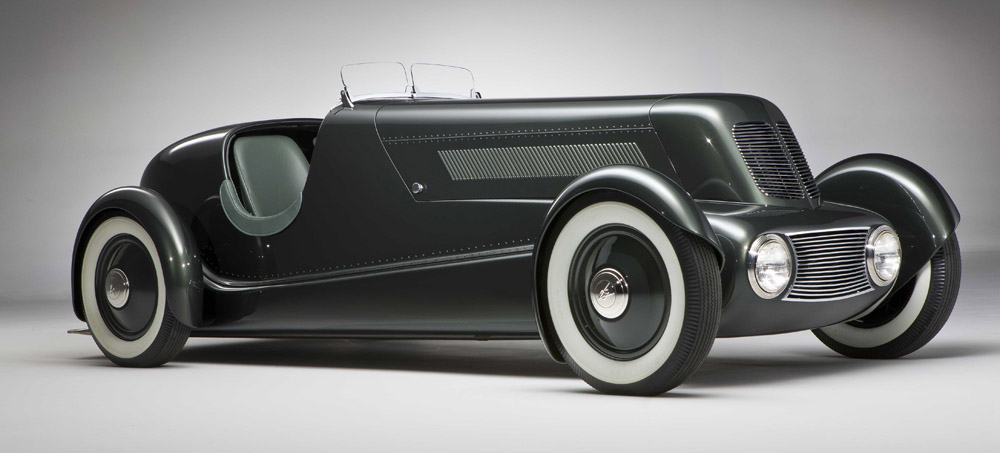
Grace, style and a 77-year history shrouded in mystery. For decades, Edsel Ford’s 1934 Model 40 Special Speedster has intrigued automotive collectors, enthusiasts and writers worldwide. After a year-long restoration taking it back to its timeless elegance, the Speedster was unveiled at Pebble Beach Concours d’Elegance in Monterey County, Calif. in August 2011 and is travelling to museums and car shows throughout the country.
Part of the permanent collection of Edsel & Eleanor Ford House in Grosse Pointe Shores, Michigan, the 1934 Model 40 Special Speedster is an example of the elegance and artistry of Edsel Ford’s impact on design and the style revolution of the 1930s.
Its rich history began in 1932 after Edsel returned from a trip to Europe. He asked Ford’s chief designer, E.T. “Bob” Gregorie to design and supervise the construction of a personal sports car similar to those he’d see “on the continent.”
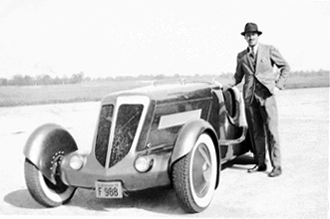 The first design reportedly disappointed Edsel because it wasn’t lower and racier. But Gregorie, who was adept at turning Edsel’s visions into tangible designs, went to work on a more dramatic, streamlined design. This “continental” roadster may have started with a stock 1934 Ford (aka Model 40) frame, but its subsequent chassis was radically altered. The Model 40 Special Speedster was unlike anything Ford Motor Company had built up to that time.
The first design reportedly disappointed Edsel because it wasn’t lower and racier. But Gregorie, who was adept at turning Edsel’s visions into tangible designs, went to work on a more dramatic, streamlined design. This “continental” roadster may have started with a stock 1934 Ford (aka Model 40) frame, but its subsequent chassis was radically altered. The Model 40 Special Speedster was unlike anything Ford Motor Company had built up to that time.
At 113 inches, the Speedster’s wheelbase is approximately the same as the standard 112-inch wheelbase of a 1934 Ford roadster. Yet, it appears longer and lower. This illusion was achieved by modifying and lowering the car’s chassis, positioning the cockpit toward the rear of the car and extending the tail section.
Gregorie, Robbie Robinson, supervisor of the Lincoln plant, and Ford Aircraft Division personnel, fabricated a topless, taper-tailed aluminum body with cut-down door openings and mounted it over a custom welded tubular aluminum structural framework.
It was believed that the Speedster’s fenders were modified Trimotor Aircraft “wheel pants,” but Ford’s aircraft fabricators undoubtedly fashioned them from scratch. The custom-designed front cycle wings were mounted so they turned with the car’s Kelsey-Hayes wire wheels. The all-aluminum bodywork followed the best aircraft practice – light and very strong.
The Speedster was painted Pearl Essence Gunmetal Dark; the interior upholstered in complementary gray leather. The flat, engine-tuned instrument panel incorporated period Lincoln instruments. The 2,100-pound Speedster was powered by a stock 75-bhp, Ford Model 40 flathead, with straight exhausts that were enclosed by the bodywork with only the tips protruding.
The Speedster had low-mounted faired-in headlights; an enclosed radiator with a concealed cap, a starter button on the instrument panel; minimal chrome trim and no running boards – features that didn’t appear on production Fords for years.
The Speedster’s shapely hood had louvered side panels that subtly matched the angle of the radiator grille and the windscreen. A pair of narrow vee-ed grilles with a single row of louvers (vents) running the length of each side of the hood limited the flow of cooling air. The Speedster had a tendency to overheat.
Two period photographs of the car show two different louver treatments. One shows a single row of side louvers; the other features two rows of louvers, one atop the other. It’s reasonable to suspect that because of overheating issues, the hood was modified between the times these photos were taken.
Reportedly, a winter freeze in 1939-40 cracked the engine block; a new 239-cid, 100-bhp 09A Mercury V-8 was installed. This would have been the most powerful version of the Ford flathead V-8 available at the time.
By 1939, Gregorie had designed wider twin grilles for the Lincoln-Zephyr, so it followed that he would take the same approach for the Speedster. He redesigned the Speedster’s front end by shortening the upper grilles and fabricating a wide, horizontal grille for improved cooling. The new design, which required extensive modifications to the hood, was likely completed in 1940. The instrument panel may have been updated at the same time with a 160-mph racing type speedometer and matching Stewart-Warner accessory instruments.
“The Model 40 Special Speedster was only enjoyed by Edsel for a few short years before his death in 1943, but its journey was just beginning,” said Ford House President Kathleen Mullins. “Ford House is proud to give life to Edsel’s original vision for a unique, continental roadster.”
The Model 40 Special Speedster has moved through almost eight decades of owners and modifications and has returned to its early design elegance. After Pebble Beach, its journey will continue, ultimately returning home to Ford House.
The Life and Owners of the 1934 Model 40 Special Speedster
Creation, modification, disappearance, rediscovery, restoration
- 1934 – Edsel Ford personally titled the Speedster Sept. 21, 1934 and garaged the vehicle on the Edsel Ford estate at Gaukler Point in Grosse Pointe Shores, Mich.
- 1943 – Upon his death in May, the Speedster, valued at $200 was bequeathed to his wife, Eleanor Clay Ford.
- 1944 – Speedster sold, most likely in late 1944, and while enroute to Miami, is believed to have been sold again to a buyer in Atlanta for $1,000.
- 1947 – Shipped to Los Angeles and placed it in storage.
- 1948 – A classified advertisement in the May issue of Road & Track read: Especially constructed Ford Chassis. Aluminum body built for Edsel Ford. Now powered with special Mercury Engine. Priced reasonably at $2,500. COACHCRAFT, LTD, 8671 Melrose Ave. In black and white photos of the car, it appears to be painted black or red. There is a radio antenna on the cowl. The Mercury engine was modified with a Thickstun dual carburetor intake manifold, a “speed cam,” and Edelbrock high-compression cylinder heads.
- 1952 – Appeared in Auto Sport Review, photographed in Hollywood with an aspiring actress named Lynn Bari.
- 1957 – Driven or transported back to Georgia
- 1958 – Registered in Florida as a 1940 “Ford custom-built speedster.” Sold for $603 to John Pallasch, a U.S. Navy sailor. It was painted red with coordinating red leather upholstery, which may have been done for an appearance in a Hollywood film. Film has not been located.
- 1960 – Pallasch partially dissembled the engine for a rebuild, shipped out to Vietnam, and, upon his return, the engine had seized.
- 1999 – Bill Warner, founder of the Amelia Island Concours d’Elegance, bought the Speedster from Pallasch. According to Warner, “The Speedster was sitting in the Pallasch garage, covered with junk and tin cans, so no one would know it was there. Remarkably, it was complete expect for the wheel discs. The speedometer read just over 19,000 miles.” On his way back to Amelia Island, Warner visited Bob Gregorie who was 91 years old and residing in St. Augustine, Florida. Warner reported that Mr. Gregorie came out of his house, smiled and said, “I haven’t seen it since 1940. The old girl still looks pretty good for her age.” According to Warner, Gregorie confirmed that the Speedster was originally dark gray with gray leather upholstery. He also commented that the Speedster “looked really good in red.” Warner considered a complete restoration of the car to the Speedster’s first iteration, but decided to preserve the Edsel Speedster’s remarkable patina. He touched up the paint and rebuilt the engine, retaining the Thickstun dual carburetor manifold and removing the Edelbrock heads.
- 2008 – Warner sold the Speedster at an RM Amelia Island Auction in March for $1.76 million to Texas collector John O’Quinn. After O’Quinn’s untimely death in 2009, Edsel Ford II arranged for the Speedster’s purchase for permanent display at the Edsel & Eleanor Ford Estate.
- 2010 – In August, Edsel & Eleanor Ford House sent the Speedster to RM Restorations in Blenheim, Ontario, where it was closely examined, extensively photographed and then carefully and completely dismantled.
- 2011 – The restored Model 40 Special Speedster was unveiled at the Pebble Beach Concours d’Elegance on August 19, 2011.
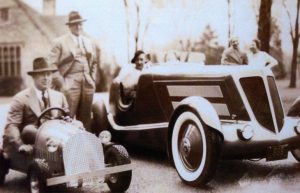
The impact of Edsel Ford – Elegance, Artistry, Style, Design
Edsel Ford’s distinct impact on the style revolution of the 1930s – from minimalist lines to shiny surfaces that mirrored the world of modern art – was born out of a desire to reflect art in everyday, mass-produced objects. His collaboration with designer E.T. “Bob” Gregorie allowed this approach to art to take shape in automobiles.
Edsel and Gregorie created elegance on wheels from the custom 1934 Model 40 Special Speedster, to production vehicles like the 1941 Lincoln Continental Cabriolet, which Frank Lloyd Wright called “the most beautiful car in the world.” Gregorie became adept at visualizing Edsel’s creative ideas through sketches, and could skillfully translate concepts from two to three dimensions. “Even though there were two of us, we thought as one,” said Gregorie in a 1985 interview. “My hands became Edsel’s tools in developing designs. I was able to put on paper and into clay the designs he was visualizing in his head.”
In the Spring of 1935, Edsel, as president of Ford Motor Company, appointed Gregorie to lead Ford’s first design team. “Although Ford had only one-tenth the number of designers that were employed at GM, the cars designed at Ford during the Edsel Ford years displayed understated elegance and sculptured simplicity,” wrote Jim Farrell in his book, Ford Design Department: Concept to Show Cars, 1932-1961. “They have aged well (as collectors would attest) because of him.”
Edsel’s exactness guided the style at Ford Motor Company in the 1930s and beyond. His modifications to the boxy Model T created the stylish Model A, which featured the hallmarks that would become Edsel’s design signature: clean, graceful lines, minimal adornment and fine, delicate grille work and trim.
Restoration of the 1934 Model 40 Special Speedster Confirms Custom Design and Engineering
Design helped shape the styling of future Ford vehicles
In August 2010, the Model 40 Special Speedster was taken to RM Auto Restoration, Blenheim, Ontario, Canada, where it was closely examined, extensively photographed and completely dismantled.
RM Auto Restoration meticulously restored all suspension parts, the cross steering components, the three-speed manual transmission, the rear end, and a 1940 Ford V-8 engine. In the process, a number of discoveries were made:
The steel chassis is custom-built. Two cross members in the front facilitate the engine’s rearward placement. The center cross members resemble standard Ford components of that period, but there are no openings and there are additional gussets and plates. Outriggers on the frame, covered with a layer of felt, ensure the body attaches firmly, retains its shape and does not squeak.
The body was stripped to bare metal and evidence of the 1940-era grille and hood alterations were clearly apparent. RM’s expert craftsmen believe the new metalwork was done by some of the same Ford Aircraft artisans who initially built the car. It was evident that the beautiful aluminum body was skillfully crafted and its individual sections were welded together to make it one-piece construction. The workmanship of the Speedster mirrors the best aircraft fabrication practice of the 1930s, helping to substantiate the fact that the Speedster was built by Ford Aircraft personnel.
As layers of paint were removed, coats of primer, gray, possibly black and certainly red paint became evident. The aluminum body has been metal-finished and the ‘crispness’ of the pointed tail section has been restored.
The chassis has been painted black; the rebuilt stock Ford engine is the correct shade of Ford green. Using a period R-M (Rinshed-Mason) color chart, the appropriate shade of Gunmetal Deep 80104 (Gunmetal Deep Ground) was identified and computer-matched for the utmost accuracy.
Although the existing red leather upholstery appeared to be period authentic, a dark gray leather was selected based on written evidence and Bob Gregorie’s confirmation to Bill Warner that gray was the original color.
Double-sided white wall tires, as were fitted originally, have been installed. The decision was made to keep the present instrument panel.

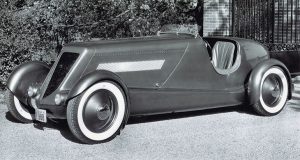

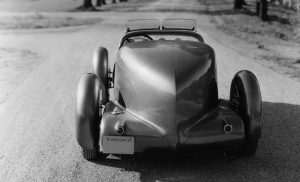


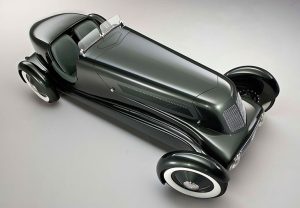
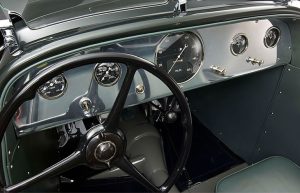
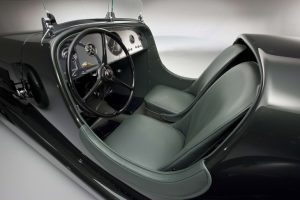

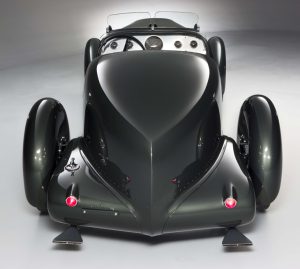

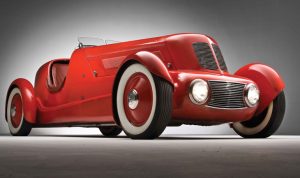
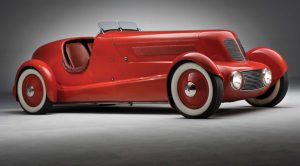

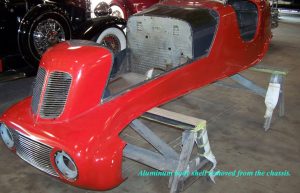
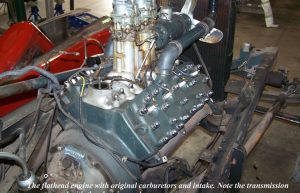
You must be logged in to post a comment.